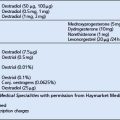CHAPTER 15 RHEUMATOLOGY AND ORTHOPAEDICS
JOINT PAIN
Diagnosis
History.
Investigations.
If the diagnosis remains unclear having taken a careful history and examined the relevant parts, bloods can be requested for FBC, ESR and CRP, rheumatoid factor and serum uric acid. See the patient after 2 weeks. Insignificant causes will produce normal results (except, perhaps, for a slightly raised ESR in viral illnesses).
Persistent abnormality prompts management as in the relevant sections listed in the box on p. 238, or referral for further diagnostic tests.
NECK PAIN
Neck pain is commonly a mild, self-limiting nuisance due possibly to muscle tension.
Diagnosis
History
OSTEOARTHRITIS
Diagnosis
Management
Advice
Treatment
POLYMYALGIA RHEUMATICA AND GIANT CELL ARTERITIS
Polymyalgia rheumatica is a common condition in Caucasians, mainly affecting women over 55. It coexists with giant cell arteritis in about 30% of cases (see p. 232).
Diagnosis
Examination
Investigations
Management
OSTEOPOROSIS
Diagnosis
The condition itself is asymptomatic, but the following put patients at increased risk:
RHEUMATOID ARTHRITIS
Diagnosis
History.
Examination.
Management
Care of the acute case.
Care of the chronic case
SHOULDER PAIN
Shoulder pain can be a symptom of problems in the neck, such as cervical spondylosis, but is usually caused by either adhesive capsulitis (frozen shoulder) or the rotator cuff syndrome (e.g. supraspinatus tendonitis). Consider cardiac ischaemia or diaphragmatic irritation as a possible cause, e.g. gallstones.
Diagnosis
Examination.
Management
TENNIS ELBOW
Management
TENOSYNOVITIS
CARPAL TUNNEL SYNDROME
Management
GANGLION
PARONYCHIA
LOW BACK PAIN
ACUTE PRESENTATION
Management
In the absence of neurological signs:
KNEE PAIN
After low back pain, knee pain is the second most common orthopaedic problem in general practice.
Diagnosis
History.
Without trauma.
If the pain has been present for some time consider e.g.:



